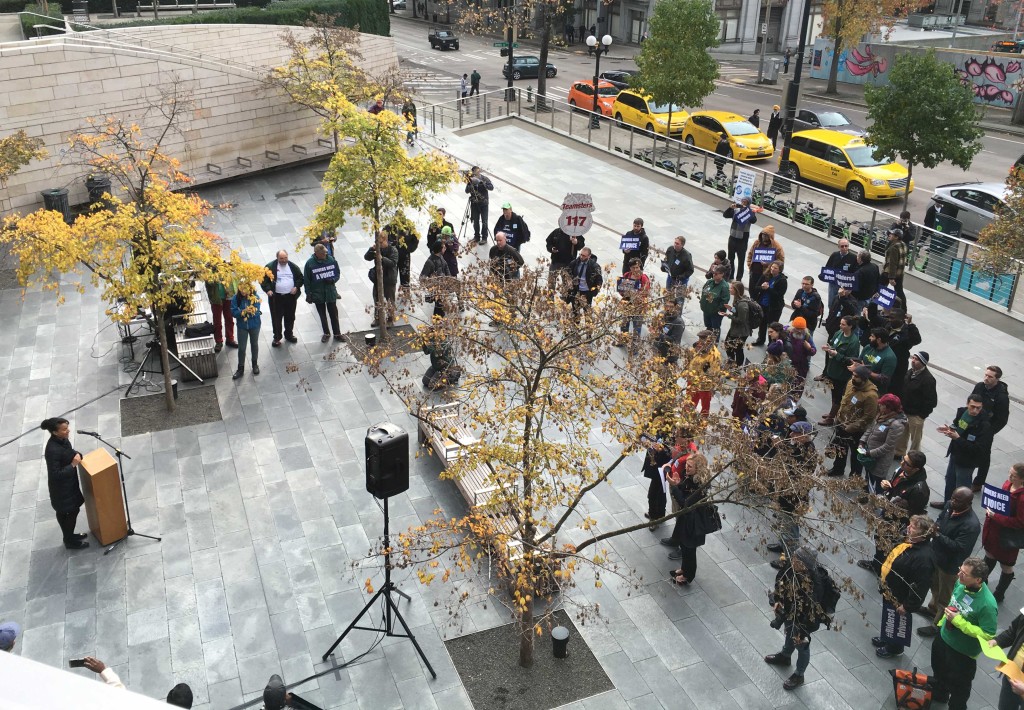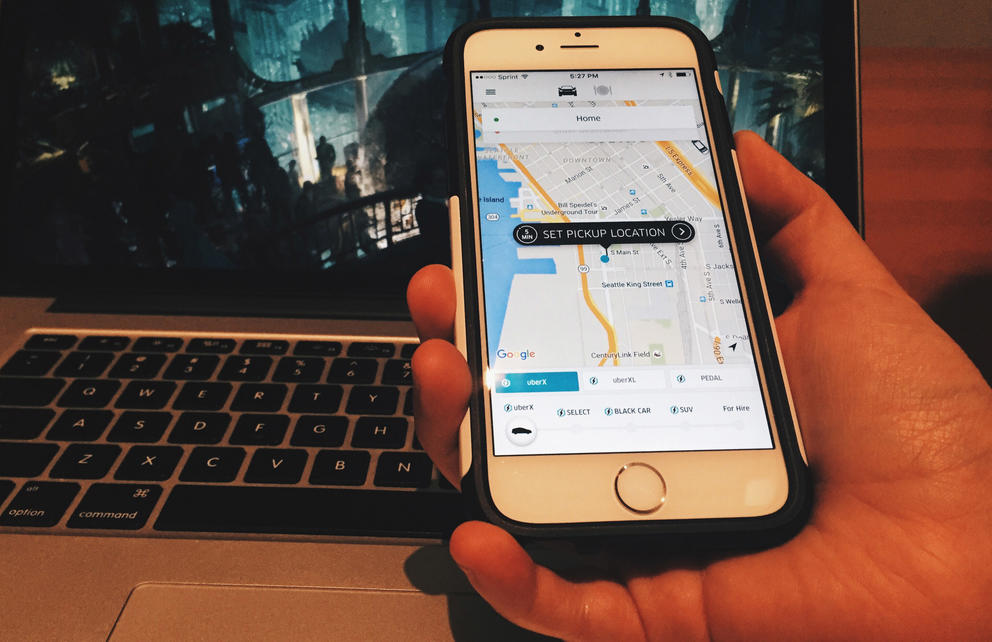This Friday, Obama strategist-turned-Uber spokesman David Plouffe will be in town to deliver a speech entitled “Uber and the Future of Work”. The event is being held at a Pioneer Square shared-office space favored by techie entrepreneurs, but Plouffe’s real audience is probably four blocks north at City Hall, where the city council is considering legislation that Uber and its rivals do not like — a first-in-the-nation law to allow the drivers of ride-hailing apps like Uber and Lyft to collectively bargain.
The legislation, sponsored by Council member Mike O’Brien, covers only the roughly 14,000 for-hire drivers operating locally. But the industry, according to labor activists, is terrified that Seattle’s law will inspire copycat legislation in other states and throttle the low-cost model that has powered the industry’s success.
Plouffe’s visit to Seattle “is a Hail Mary pass to try to stop the drivers from getting their bill,” says Nicole Grant, Executive Secretary-Treasurer with the King County Labor Council. “The timing definitely points to damage control.”
Certainly, the “Hail Mary” theory feels plausible. Even as consumers celebrate the promise of ride-hailing services for cheap, efficient transportation, the industry is taking serious heat over the way it delivers that product. Ride-hailing companies, critics say, have not only cut their rates so low that many full-time drivers struggle to make minimum wage. They’ve also turned to heavy-handed measures against drivers who push back, reportedly suspending drivers who attempt to organize or even speak out against the company.
Such methods help explain why liberal enclaves such as New York and Seattle see the ride-hailing industry as a new front in the battle against the gig economy’s inequities —an aspiration that is now resonating nationally, with even Hillary Clinton now promising to “crack down on bosses who exploit employees by misclassifying them as contractors or even steal their wages.” Ride-hailing companies have tried to counter this reform impulse with an army of attorneys, lobbyists, and flacks. But as Seattle moves its legislation forward—a vote is expected in two weeks—many activists here believe the industry is effectively cornered.
“If I were Lyft or Uber, I would be on a plane to Seattle,” David Rolf, with the local Service Employees International Union, said last month, weeks before Plouffe’s visit was announced. “And I would be willing to sit in a room with labor and the mayor and the council leadership and say, ‘Let’s do what we did with the [$15 an hour minimum wage] and have a difficult but ultimately productive negotiation.’”
And yet, it’s just as easy to imagine Plouffe not doing any of those things. As vulnerable as Uber and its rivals might seem right now, there are a host of reasons that Seattle’s reformers may not see a unionized ride-hail workforce anytime soon.
Start with the legal problems. While there’s little question that “the balance of power between companies and workers is askew,” as O’Brien puts it, it’s also clear ride-hailing services will happily litigate to block the city’s rebalancing efforts for years, and could well prevail.
Because federal law classifies ride-hail drivers as independent contractors, not employees, drivers don’t enjoy protection under the National Labor Relations Act. This means a federal court might slap Seattle down for attempting to preempt federal labor law, says Jeffrey Hirsch, a labor law expert at the University of North Carolina School of law and a former litigator for the National Labor Relations Board. Of course, Seattle might win, extending long-overdue federal protections to the “1099” workforce. But such an outcome is hardly certain and is at least two to three years away, Hirsch says. In the meantime, Seattle drivers attempting to organize under a new city law could be sued by Uber for price-fixing under federal antitrust laws.
Likewise, there are technical challenges in determining which of the city’s thousands of drivers could vote on unionization. Under the law, the city will assemble a list of fulltime drivers and turn that information over to local unions, which will then try to persuade a majority of them to unionize. But as the city’s own Financial and Administrative Services department has warned, ride-hailing services have famously high churn rates (by some studies, half of all drivers don’t last a year), and the city will struggle to determine whether a majority actually favors unionization. This will invite still more industry litigation.
Add in the fact that Seattle will be getting this driver information from the ride-hailing companies themselves—companies famously unwilling to share data of any kind—and it’s easy to see this as yet another example of Seattle’s penchant for well-intended social policy that is difficult to pull off.
But the real obstacle is more basic: a mismatch between the old labor model the city is backing, and the very new industry it’s hoping to rein in. It’s not that Uber and Lyft don’t care about mutinous drivers: even small work stoppages or other disruptions could tarnish the fantasy of virtually instant transportation that has made ride-hailing apps the killer consumer commodity. In fact, Uber cut rates from $1.35 per mile to $1.10 in January, and some Seattle drivers threatened to turn off their phones and stop picking up customers. The company promptly rescinded the cuts, the only city where that has occurred, says Dawn Gearhart, an official at the local Teamsters union for taxi drivers, who is helping to push O’Brien’s bill.
An Uber spokesman insists, somewhat dubiously, that Uber raised the rates back because company data showed that Seattle was the only city where the original drop in rates hadn't raised driver income by increasing the number of passenger trips. We have a request into Uber for information to back up the claim.

But since that modest victory (the restored rate was still a dollar less than the 2014 rate) drivers haven’t been able to muster the kind of large-scale, sustained actions that might bring ride-hailing services to the bargaining table. Protests generally have been small and poorly covered in the press: the noisy crowd that showed up at City Hall last month to support O’Brien’s law consisted mostly of labor organizers, Sawant supporters, and other activists, with only a sprinkling of actual drivers from ride-hail companies. Likewise, driver advocacy organizations have struggled to gain members. The Seattle-based App-Based Drivers Association, launched by the Teamsters in 2014, has just five hundred drivers as members —a small fraction of the full-time drivers who are the most plausible candidates for union action.
Which brings us to the question: why aren’t more rank-and-file drivers stepping up? To hear industry proponents tell it, the reason is only a minority of drivers are unhappy. The push to unionize, in this account, is less about worker grievances than it is about unions trying to pad their thinning ranks. Anecdotally, you can find plenty of drivers who seem genuinely pleased with the flexibility the ride-hailing industry allows, especially among part-timers. But labor activists argue that the low turnout for unionization efforts also reflects the industry’s anti-union tactics.
Some of these tactics are little more than bribery—Gearhart says companies in Seattle have tried to tempt drivers away from union activities by offering them a guaranteed hourly rate of $35 or a free Ezell’s chicken dinner during the hours the union has scheduled a meeting.
Other tactics are substantially more aggressive. At last month’s rally at Seattle City Hall, one Seattle-based Lyft driver described being “de-activated” the day after attending a Teamsters meeting. In an email, a Lyft spokesperson insisted the deactivation followed a customer complaint. Two weeks ago, a Bay Area Uber driver reported being temporarily suspended after he questioned Plouffe about rate cuts during a presentation Plouffe was giving at the Next Economy Conference in San Francisco. Uber has denied the charge.
But some labor leaders here acknowledge another, less flattering explanation: conventional union strategies, many of them devised in the 1930s, may no longer seem relevant to workers in a 21st century, app-driven industry.
Like other parts of the gig economy, the ride-hailing business has no central factory where unions can recruit members or stage strikes. Drivers face management techniques – like location tracking and fluctuating pay scales – that traditional union strategies can’t address. More broadly, where the labor movement could once count on heavy government support for collective action, today’s activists and workers have few such assurances.
Furthermore, drivers for ride-hailing services don’t know whether the current attentions of liberal politicians aren’t merely passing fancy. After all, taxi drivers have operated for decades as independent contractors, often vigorously exploited by taxi firms, without attracting much sympathy or action from the political class. By some accounts, it was only when Uber and Lyft started recruiting millennial drivers that the plight of the independent contractor began “making an impact in political circles,” says Harry Campbell, a San Francisco-based analyst who follows the ride-hailing industry at rideshareguy.com.
Given that the full-time drivers who might most benefit from collective action are often the same immigrants who used to drive taxis, it’s not hard to imagine a quick drop off in national political support for ride-hail unionization once the 2016 elections are over.
These are a few of the reasons that some labor leaders are scrambling to develop new strategies. Among these is SEIU’s Rolf, who has largely abandoned the traditional labor model as “broken” and has urged his fellow activists to experiment with different models. The results so far have been mixed. O’Brien, for example, had originally hoped to empower drivers by simply capping the number of ride-hail cars in the city and thus forcing Uber, Lyft and others to bid for drivers’ services. The idea ran afoul of pretty much everyone, including consumers. Others activists have proposed more tech-centered solutions, such as creating software that enables drivers to run their own ride-hailing network. Yet it’s not clear how such a network could compete with big brands like Uber or Lyft.
Rolf favors a hybrid approach that mixes the carrot of a more cooperative approach with the stick of old-school collective bargaining. One such carrot is something called “portable benefits,” a system that would give independent contractors access to benefits like health insurance or pensions. Backed by power players such as local venture capitalist Nick Hanauer, the idea has attracted serious interest from political leaders and CEOs, including the founders of gig economy firms like Handy, Instacart, and, notably, Lyft, though not Uber.
Skeptics will argue that Lyft is merely hoping to recast itself as the “good cop” to Uber’s bad one, and that the portable benefits idea remains just a pleasant, vague talking point with zero regulatory teeth. Regardless of the idea’s merits, what may be as important is that players in the gig economy are making overtures. While Lyft is clearly seeking some good press, it’s fair to ask whether the company might also be seeking a peaceful way out of a situation that goes beyond image problems.
It’s no secret that ride-hailing services are worried by high driver churn rates, which according to analyst Campbell may indicate the industry is approaching the lower limits of its low-cost, no-benefits model. “There is a mathematical [minimum amount] they can pay drivers,” Campbell says. “And I think they’re flirting with that number.” To continue to push rates down will not only increase churn rates and bad press, but will likely raise the risk of serious accidents —and the devastating publicity they would bring—as harried drivers cut safety corners in order to make a buck, O’Brien says. This is one reason, Campbell and others say, that ride-hailing services are trying ideas like UberPool, which allows customers to share rides at a discounted price: Uber can keep making rides cheaper without necessarily cutting drivers’ pay.
The ride-hailing industry may not be ready to implode or come groveling to the Seattle City Council. But companies may be more amenable to some sort of peace negotiations than they let on. Taking advantage of that potential opening will perhaps require the city to develop a more nuanced approach to collective bargaining, one that employs the brains of newer strategies but keeps a little of the brawn of the old. As Rolf notes, the traditional labor model of “granite meeting halls, grievances procedures, funny logos on silk screened jackets, convention delegates, and strikes” may no longer be sufficient to cope with the gig economy. But it was the threat of involvement by old-school unions that got the ride-hailing industry agitated again. With the arrival of the Teamsters to the fight, Rolf says, Uber “is definitely paying attention.”



